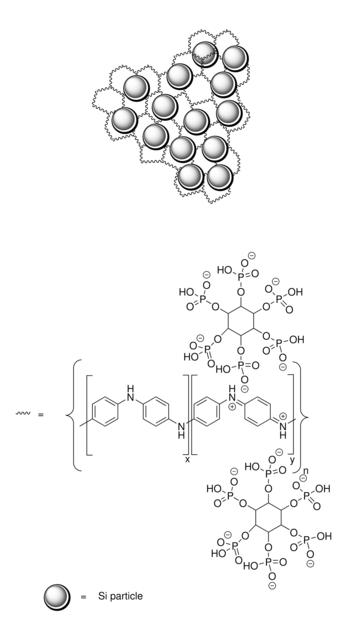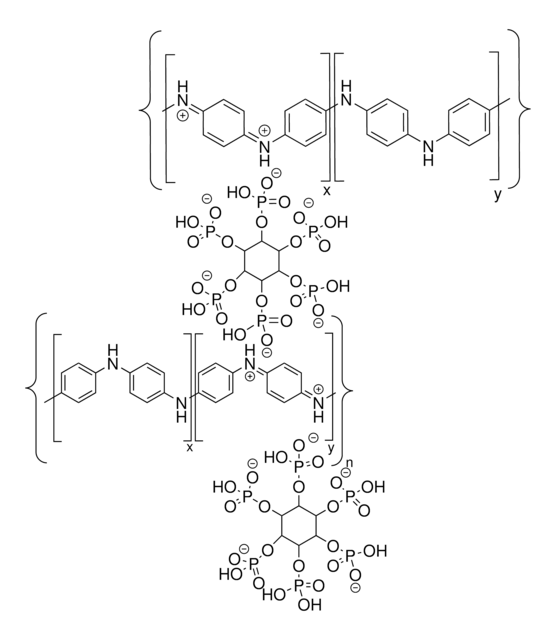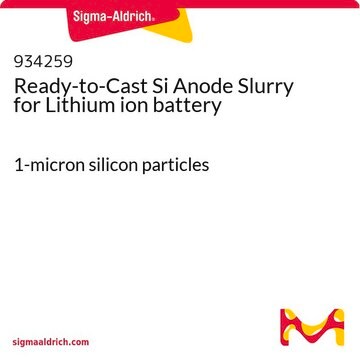912409
High-performance silicon anode
1 micron silicon particles in crosslinked conducting polyanaline matrix
Sinônimo(s):
Doped polyaniline, Si encapsulated in 3D crosslinked polyaniline, Si/PANi composite, Silicon micron particle
Faça loginpara ver os preços organizacionais e de contrato
About This Item
Código UNSPSC:
12352103
NACRES:
NA.23
Produtos recomendados
Nível de qualidade
Formulário
solid
Procurando produtos similares? Visita Guia de comparação de produtos
Aplicação
Silicon is a most promising next generation lithium ion battery electrode material, due to its ~10 times higher specific capacity (3600 mAh/g) than graphite (372 mAh/g). However, silicon experiences large volume change (~400%) during lithium insertion, causing it to fracture and detach from current collector, rendering prototypical lithium-silicon batteries to lose most of their capacity in less than 10 charge-discharge cycles. A solution to the capacity and stability issues posed by the significant volume expansion upon lithiation of silicon is critical to the success of high capacity lithium ion batteries.
This silicon/PANi composite utilizes a doped, intrinsically conductive, 3D cross-linked polyaniline as matrix, which could function as both the conductive binder and the polymer electrolyte for silicon-based electrodes. Previous study for a similar silicon-based three-dimensional conducting polymer composite demonstrated increased electrochemically performance due to short diffusion paths and good 3D connectivity, and resulted in a marked improvement in cyclability, with over 90% capacity retention after 5,000 cycles.
This composite is made by encapsulating silicon particles in an in-situ polymerized 3D-crosslinked conductive polyaniline framework. This Si/PANi composite not only allows fast electrical and ionic transport, but also provides free space to allow giant volume expansion. This Si/PANi composite provides a ready-to-use electrochemically active silicon composite that would increase the capacity of conventional lithium ion battery, and improve the cycle-life of Si-based anodes.
This silicon/PANi composite utilizes a doped, intrinsically conductive, 3D cross-linked polyaniline as matrix, which could function as both the conductive binder and the polymer electrolyte for silicon-based electrodes. Previous study for a similar silicon-based three-dimensional conducting polymer composite demonstrated increased electrochemically performance due to short diffusion paths and good 3D connectivity, and resulted in a marked improvement in cyclability, with over 90% capacity retention after 5,000 cycles.
This composite is made by encapsulating silicon particles in an in-situ polymerized 3D-crosslinked conductive polyaniline framework. This Si/PANi composite not only allows fast electrical and ionic transport, but also provides free space to allow giant volume expansion. This Si/PANi composite provides a ready-to-use electrochemically active silicon composite that would increase the capacity of conventional lithium ion battery, and improve the cycle-life of Si-based anodes.
Código de classe de armazenamento
11 - Combustible Solids
Classe de risco de água (WGK)
WGK 3
Ponto de fulgor (°F)
Not applicable
Ponto de fulgor (°C)
Not applicable
Escolha uma das versões mais recentes:
Certificados de análise (COA)
Lot/Batch Number
Lamentamos, não temos COA para este produto disponíveis online no momento.
Se precisar de ajuda, entre em contato Atendimento ao cliente
Já possui este produto?
Encontre a documentação dos produtos que você adquiriu recentemente na biblioteca de documentos.
Deformation and stress in electrode materials for Li-ion batteries.
Mukhopadhyay A, et al.
Progress in Materials Science, 63, 58-116 (2014)
Hui Wu et al.
Nature communications, 4, 1943-1943 (2013-06-05)
Silicon has a high-specific capacity as an anode material for Li-ion batteries, and much research has been focused on overcoming the poor cycling stability issue associated with its large volume changes during charging and discharging processes, mostly through nanostructured material
Ye Shi et al.
Advanced materials (Deerfield Beach, Fla.), 29(22) (2017-03-23)
This study develops a tunable 3D nanostructured conductive gel framework as both binder and conductive framework for lithium ion batteries. A 3D nanostructured gel framework with continuous electron pathways can provide hierarchical pores for ion transport and form uniform coatings
Fei Zhao et al.
Advanced materials (Deerfield Beach, Fla.), 30(48), e1801796-e1801796 (2018-08-21)
Nanostructured materials are critically important in many areas of technology because of their unusual physical/chemical properties due to confined dimensions. Owing to their intrinsic hierarchical micro-/nanostructures, unique chemical/physical properties, and tailorable functionalities, hydrogels and their derivatives have emerged as an
Ye Shi et al.
Nano letters, 17(3), 1906-1914 (2017-02-14)
Controlling architecture of electrode composites is of particular importance to optimize both electronic and ionic conduction within the entire electrode and improve the dispersion of active particles, thus achieving the best energy delivery from a battery. Electrodes based on conventional
Nossa equipe de cientistas tem experiência em todas as áreas de pesquisa, incluindo Life Sciences, ciência de materiais, síntese química, cromatografia, química analítica e muitas outras.
Entre em contato com a assistência técnica






